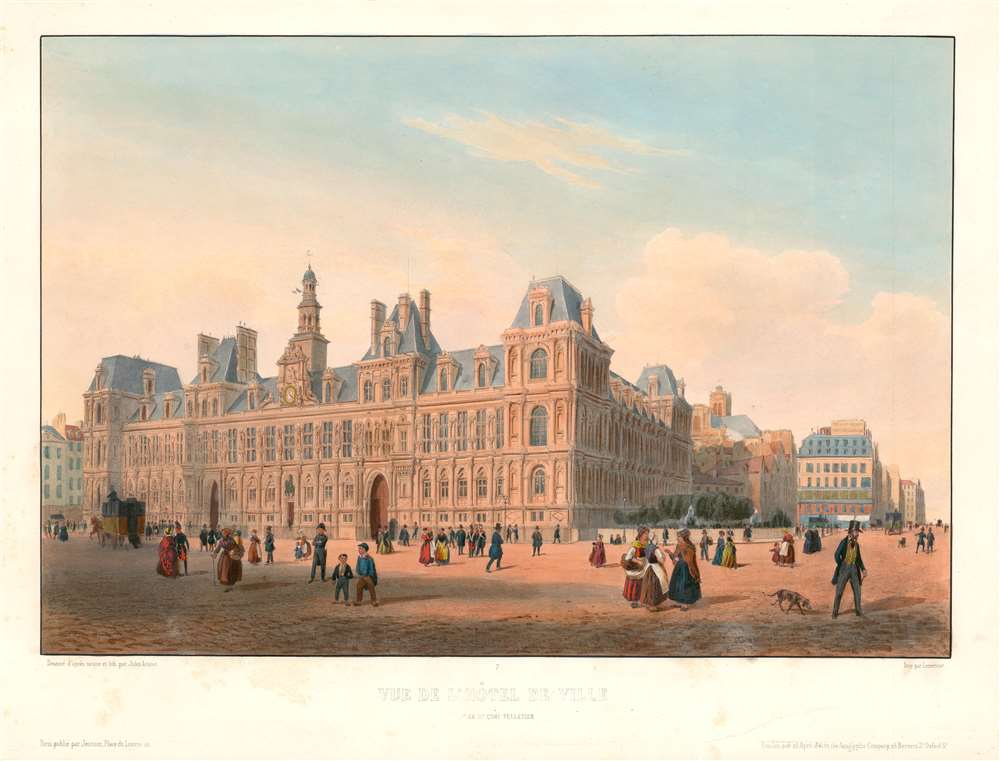This item has been sold, but you can get on the Waitlist to be notified if another example becomes available, or purchase a digital scan.
1844 Arnout View of the Hotel de Ville (City Hall) in Paris, France
HoteldeVille-arnout-1844
Title
1844 (dated) 13.5 x 17.5 in (34.29 x 44.45 cm)
Description
A Short History of the Hôtel de Ville
The Hôtel de Ville as it is depicted here was constructed between 1533 and 1628, with construction being interrupted by the French Wars of Religion which happened intermittently throughout the second half of the sixteenth century. This Hôtel de Ville was burned by the communards at the end of the Paris Commune in 1871 after it became clear that the Commune would be defeated by the French military. The building as it is in Paris today was built between 1874 and 1882.Publication History and Census
This view was created by Jules Arnout, originally printed by Lemercier and published by Jeannin c. 1844. This example is one of the British editions which was published in London by the Anaglyphic Company in 1844. The only other known example is part of the collection at the Musée Carnavalet in Paris and is in black and white.CartographerS
Louis-Jules Arnout (June 1, 1814 - September 26, 1882) was a French artist, painter, and lithographer active during the mid-19th century. His father, Jean-Baptiste Arnout (June 24, 1788 - October 5, 1873), taught Jean-Louis the art of lithography as well as painting and other art forms. Arnout created works depicting landscapes and French, Swiss, Italian, and English cities. He displayed his work at the Paris Salon in 1852 and 1865. He died in Toulouse. He had one son, Auguste-Paul Arnout. More by this mapmaker...
Rose-Joseph Lemercier (June 29, 1803 - 1887) was a French photographer, lithographer, and printer. One of the most important Parisian lithographers of the 19th century, Lemercier was born in Paris into a family of seventeen children. His father was a basket maker, and he even began working as a basket maker at the age of fifteen, but Lemercier was drawn to lithography and printing and soon entered into an apprenticeship with Langlumé, where he worked from 1822 until 1825. After working for a handful of other printers, Lemercier started his own firm in 1828 at 2, rue Pierre Sarrazin with only one printing press. He subsequently moved a few more times before arriving at 57, rue de Seine, where he founded the printing firm Lemercier and Company. He created the firm Lemercier, Bénard and Company in 1837 with Jean François Bénard. Lemercier bought out Bénard's share in the firm in 1843 and, since his two sons died at a young age, he decided to bring his nephew Alfred into the business beginning in 1862, who would progressively take on more and more responsibility in running the firm. Between 1850 and 1870, Lemercier's firm was the largest lithographic company in Paris. The firm began to decline in prestige in the early 1870s, and, after Lemercier's death in 1887, its descent only quickened. It is unclear when the firm closed, but Alfred directed the firm until his death in 1901. Learn More...
Henri Jules Jeannin (fl. 1829 - 1854) was a French print publisher active in Paris in the mid 19th century. Jeannin maintained offices at No. 20, Rue du Croissant in Paris from 1829 - 1835 and then move is office to No. 20, Place du Louvre in Paris. Little else is known about Jeannin. Learn More...

